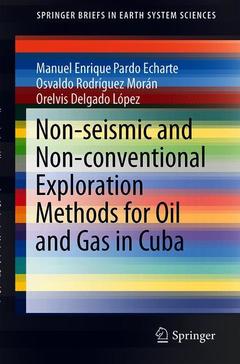Foreword
Preface
Chapter 1. Results of the petroleum systems exploratory method in Cuba. (18 figures)
Abstract
1.0 Introduction
1.1 Geographic location and general characteristics
2.0 Theoretical Framework
2.1 Petroleum systems concepts
2.2 Geological Premises
3.0 Materials and Methods
3.1 Information and its sources
4.0 Results
4.1 Cuban source rocks
4.2 Cuban oil families
4.3 Oil-source rock correlation
4.4 Geographic limit and stratigraphy extension of Petroleum Systems in Cuba
5.0 Conclusions
References
Chapter 2. Results of non-seismic and non-conventional exploration methods in the regions of Ciego de Ávila and Sancti Spiritus, central Cuba (24 figures)
Abstract
1.0 Introduction
1.1 Geographic location and general characteristics
1.2 Geological Task
2.0 Theoretical Framework
2.1 Geological Premises
3.0 Materials and Methods
3.1 Information, its sources and processing
4.0 Results
4.1 Results of non-seismic geophysical-morphometric methods
4.2 Results of non-conventional geophysical-geochemical methods (Redox Complex)
4.2.1 Results of Campaigns I and II (Ciego de Ávila Region)
4.2.2 Results of Campaign III (Sancti Spiritus)
5.0 Conclusions
References
Chapter 3. Results of Non-seismic Exploration Methods in the Habana-Matanzas region, Cuba (12 figures)
Abstract
1.0 Introduction
1.1 Geographical location and geological characteristics
1.2 Geological Task
2.0 Theoretical Framework
2.1 Geological Premises
3.0 Materials and Methods
3.1 Information and its sources
4.0 Results and Discussion
4.1 Processing and interpretation of information
5.0 Conclusions
References
Chapter 4. Results of some Non-seismic Exploration Methods in different gaso-petroleum regions of western and central Cuba (2 figures)
Abstract
1.0 Introduction
1.1 Geological premises that support the application of non-conventional and non-seismic geophysical-geochemical-morphometric methods of exploration
2.0 Materials and Methods
2.1 Information and its Sources
2.2 Processing and interpretation of information
3.0 Materials and Methods
3.1 Information, its sources and processing
3.0 Results and Discussion
3.1 Region east of Motembo (Motembo-Carbonates, Block 9)
3.2 Region of the surroundings of the Jarahueca deposit (Block 13)
4.0 Conclusions
References
Chapter 5. Morphotectonic regionalization in the seas of South Cuba from the Digital Elevation Model 90x90 m (10 figures)
Abstract
1.0 Introduction
1.1 Geographical location and geological characteristics
1.2 Geological Task
2.0 Theoretical Framework
2.1 Geological Premises
3.0 Materials and Methods
3.1 Information, its sources and processing
4.0 Results
5.0 Conclusions
References





